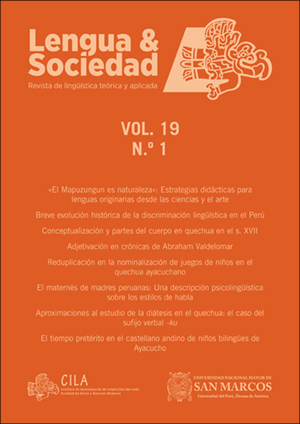The Motherese of Peruvian Mothers: A Psycholinguistic Description of Speech Styles
DOI:
https://doi.org/10.15381/lengsoc.v19i1.22319Keywords:
motherese, language acquisition, Spanish, style, communicationAbstract
Mothers often speak to their children from an early age to stimulate their communication skills and the learning of their mother tongue. This special form of communication developed between mothers (and caregivers in general) and children is called baby talk. In the acquisition process, baby talk play a central role as providers of linguistic input. The objective of this study is to analyze the Peruvian baby talk. Methodologically, two mothers and their children in early childhood have been selected and their verbal interactions recorded. In this study, the linguistic characteristics and the styles of this baby talk are described. Likewise, the difference in speech between the receptive-style mother and the unreceptive-style mother is presented.
References
Álvarez, S. (2006). Relación entre el habla materna y la adquisición y desarrollo del lenguaje en el niño. MAPRE Medicina, 17(3), 202-215. Recuperado de http://sid.usal.es/idocs/F8/ART9362/relacion.pdf
Benítez, A. (2009). Genes y lenguaje. Aspectos ontogenéticos, filogenéticos y cognitivos. Barcelona: Reverté.
Bernárdez, E. (1999). ¿Para qué sirve el lenguaje? En Autor, ¿Qué son las lenguas? (cap. 9). Madrid, Alianza.
Blanco, C. (2005). Sociolingüística y análisis del discurso: herramientas para la investigación en educación. Revista de Pedagogía, 26(76), 307-352. Recuperado de http://ve.scielo.org/scielo.php?script=sci_arttext&pid=S079897922005000200006&lng=es&tlng=es
Clemente, E., y Remírez, J. (2000). Relación entre el habla maternal y la infantile en una tarea de interacción conjunta. Revista de Psicología General y Aplicada, 53(2), 387-400. Recuperado de http://dialnet.unirioja.es/servlet/articulo?codigo=2356962
Fernald, A. (1985). Four-Month-Old Infants Prefer to Listen to Motherese. Infant behavior and development, 8, 181-195. Recuperado de http://www-psych.stanford.edu/~babylab/pdfs/Fernald%201985.pdf
Flores, M., Beltrami, L., y De Souza, A. (2011). O manhês e suas implicações para a constituição do sujeito na linguagem. Disturbios da Comunicação, 23(2), 143-152. Recuperado de https://revistas.pucsp.br/dic/article/view/8270
Gallardo, J., y Gallego, J. (2000). Manual de logopedia escolar. Un enfoque práctico. España: Aljibe.
Hitotuzi, N. (2005). Teacher Talking Time in the EFL Classroom. Profile Issues in Teachers’ Professional Development, 6, 97-106. Recuperado de https://revistas.unal.edu.co/index.php/profile/article/view/11129
Liu, H.-M., Tsao, F.-M., y Kuhl, P. K. (2009). Maternal Speech to Infants in Mandarin Chinese: Support for an Expanded Vowel Triangle in Mandarin Motherese. Washington: University of Washington.
Ibáñez, N. (2000). El lenguaje en el niño: una nueva mirada. Estudios pedagógicos, 26, 51-67. https://dx.doi.org/10.4067/S0718-07052000000100004
Karmiloff, K., y Karmiloff, A. (2001). Pathways to Language: From Fetus to Adolescent. Cambridge: Harvard University Press.
Montes, C., y Lovón, M. (2014). La adquisición de una segunda lengua Reflexiones teórico-prácticas. Lima: Facultad de Educación de la PUCP.
Mueller, V., y Hoff, E. (2007). Input and the Acquisition of Language: Three questions. En E. Hoff, y M. Shatz (ed.), The Handbook of Language Development (pp. 107-127). Blackwell. https://doi.org/10.1002/9780470757833.ch6
Moreira de Souza, M., Levy, L., y Abu-Jamra, S. (2010). O manhês: costurando laços. Estilos da Clinica, 15(2), 420-433. Recuperado de http://www.revistas.usp.br/estic/article/view/46099
Pinker, S. (1995). El instinto del lenguaje. Cómo crea el lenguaje la mente. Madrid. Alianza.
Poblete, M. T. (2002). Las repeticiones en la interacción comunicativa. Revista de Lingüística Teórica y Aplicada, 40, 147-170. Recuperado de https://dialnet.unirioja.es/servlet/autor?codigo=16159
Rivero, M. (1993). La influencia del habla de estilo materno en la adquisición del lenguaje: valor y límites de la hipótesis del input. Anuario de Psicología, 57, 45-64. Recuperado de https://dialnet.unirioja.es/servlet/articulo?codigo=2946510
Shiro, M. (2013). Expresiones de afecto de madres bilingües. Actualidades en Psicología, 27(115), 75-91. https://doi.org/10.15517/ap.v27i115.8991
Thiesen, E., Hill, E., y Saffran, J. (2004). Infant-Directed Speech Facilitates Word Segmentation. Infancy, 7(1), 53–71. http://dx.doi.org/10.1207/s15327078in0701_5
Whyatt, B. (1994). Baby talk. The Language Addresed to Language-Acquiring Children: A review of the Problem. Studia Anglica Posnaniensia, 29,125-135. Recuperado de http://ifa.amu.edu.pl/sap/files/29/10Whyatt.pdf
Downloads
Published
Issue
Section
License
Copyright (c) 2020 Marco Antonio Lovón Cueva, Arturo Martel Paredes, Melissa Tejada Tirado

This work is licensed under a Creative Commons Attribution 4.0 International License.
AUTHORS RETAIN THEIR RIGHTS
a. Authors retain their trade mark rights and patent, and also on any process or procedure described in the article.
b. Authors can submit to the journal Lengua y Sociedad, papers disseminated as pre-print in repositories. This should be made known in the cover letter.
c. Authors retain their right to share, copy, distribute, perform and publicly communicate their article (eg, to place their article in an institutional repository or publish it in a book), with an acknowledgment of its initial publication in the journal Lengua y Sociedad.
d. Authors retain theirs right to make a subsequent publication of their work, to use the article or any part thereof (eg a compilation of his papers, lecture notes, thesis, or a book), always indicating its initial publication in the journal Lengua y Sociedad (the originator of the work, journal, volume, number and date).



























